Effective Communication in the Workplace - Communication Research
There is a whole industry built on helping you to become a better communicator. Unfortunately, some of what is written about this topic is rather misleading. For example, many people have misinterpreted and misquoted the findings of Albert Mehrabian's research, which created the '7%-38%-55% rule' or the '3 V's.'
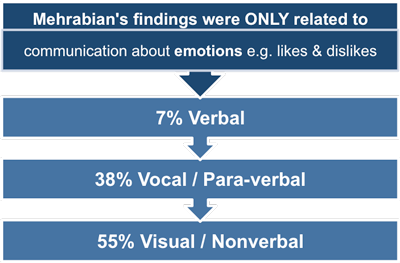 |
Mehrabian's research, conducted in 1967, was concerned with the relative importance of verbal and nonverbal signals when communicating feelings and attitudes, rather than general everyday or workplace communications. However, it has been cited as applying to all forms of communications and has been interpreted as stating that over 80 percent of all communications is nonverbal.
This misinterpretation of Mehrabian's findings has been repeated so many times that it has become widely believed that nonverbal elements are more important than the actual words used to communicate a message. This is simply not true in the case of most workplace communication.
The ability to explain and get across complex ideas, messages, and instructions is paramount for a manager. Using all the three types of signals - verbal, para-verbal, and nonverbal - to ensure that your message is comprehended and received in a positive way is an essential aspect of your communications skills.
Verbal Signals
You should not underestimate the impact of the spoken or written word. How you phrase your message and the actual words used can totally alter the meaning of your message.
In your management role you need to express your requirements, approach, ideas, and strategies clearly so all who hear understand. In the majority of cases you will want to use positive language, telling people what you want or can be done, rather than what you don't want or cannot be done.
 |
It is important to remember when selecting your words to make sure that your choice portrays the level of authority and respect your communication requires. It is essential that your words convey the same meaning to all your audience regardless of their level of knowledge.
Be mindful of jargon, and when to use it in your communications. Also your words need to present a logical description of the action you need to take place to achieve your objective or perform your role. You want the words to appear natural and appropriate to the situation.
The importance of your words increases tenfold when you are communicating in writing. This is because your reader or audience only has the words in front of them to ascertain your meaning and the required action. Making sure your grammar and spelling are correct is essential in this type of communication.
Para-Verbal Signals
The next level of signals you give to those you speak to are the para-verbal or vocal signals. These are important aspects because often without realizing it you will convey meaning in how you deliver what you say.
These signals include such things as the tone you use when speaking. Does your voice sound as if you are pleading with your team to perform their tasks? Or does it come across as a suitably authoritative request for information about how the task is progressing?
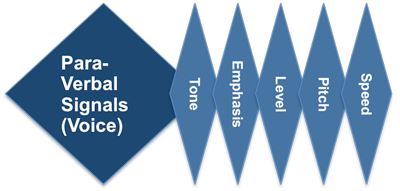 |
The pitch and volume of your voice also convey meaning to your audience. For your message to be effective these must match your words. If your voice is naturally quiet or soft you will have to develop your delivery technique so that your voice has the appropriate ring of authority for the situation.
It is this group of signals that will convey your exact meaning or help you to modify it to suit your audience or circumstances. They also convey your attitude and emotion towards the communication. When you feel strongly about an issue you may find that your voice rises, but this level and pitch may not reflect the right attitude for your communication.
Shouting at someone who isn't doing what you want them to do is not the way to correct such behavior. You may need to offer further instructions or information so that they review how they are conducting the task. You may need to clarify that their understanding of what you want done matches what you want them to do.
Your dominant emotion when communicating is easily discernible in the speed of your delivery. Those who are nervous or anxious will tend to talk more quickly, often giving the impression of a lack of confidence or knowledge. Being able to control your emotions when communicating indicates an effective communicator. Your ability to do this relates to your level of emotional intelligence.
Being able to influence the para-verbal signals you use when communicating is a significant skill, and directly relates to how effective your communications are. You will need to focus on this area when developing your communication skills.
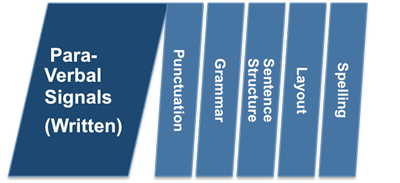 |
In writing, the para-verbal signals are communicated by your use of punctuation, grammar, spelling, and the structure of your sentences. Your para-verbal abilities must reflect your level of authority. Poorly spelt or phrased sentences can be as detrimental to the communication of your message as shouting or excessive use of jargon.
The use of elements such as bullets, capitalization, bold, etc. in the layout of your document allows you to emphasize key points. Presenting your argument in a logical manner is also a significant factor in communicating well in writing.
Nonverbal Signals
This group of signals, often referred to as body language, plays a key role in how effective your communications will be, but it must not be your sole focus. Each of the three signal areas has a role to play in how effective your communications are, and the proportion assigned to each will vary according to the circumstances of each exchange.
Your nonverbal signals, or body language, provide your audience with the clues they will use to determine your attitude and feelings towards the communication. These include such things as your posture, facial expressions, and gestures.
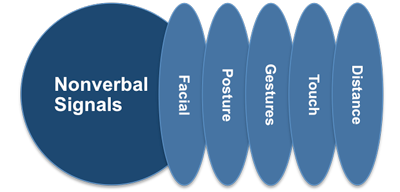 |
It is well known that your facial expressions reveal your true emotion in a situation. Your eyes and lips will reflect how you feeling about an exchange. Different cultures focus on different aspects of the face when assessing the emotional reaction of the person they are speaking to.
These cultural differences are also noticeable in the gestures and element of touch used in an exchange. People from the southern Mediterranean, for example, are known to be more expressive in their hand and arm gestures than many other cultures.
They also are quite tactile when communicating and may perceive you as being less approachable or more authoritarian in your communications if you avoid touching. If you do not reciprocate in a way that reflects the behavior of the person you are communicating with, the emphasis or empathy you want to express may be misinterpreted.
When you are communicating you need to be conscious of the posture you adopt. This is because it informs those involved in the exchange how attentive you are and how interested you are in what is being said.
An open posture generally shows you are more supportive of what is being said than a closed one. But if your posture appears too relaxed, and you maintain little eye contact, you may portray the attitude of someone uninterested in the topic.
The other aspect posture communicates during an exchange is how comfortable the other person is with the distance there is between you. Each individual's level of personal space is unique and is a reflection of their culture and character.
You need to quickly pick up on such signals when communicating and if you are too close to the other person then you need to subtly move away from them until you see them relax.
If you are observing a conversation you will also be able to identify how close or personal the relationship between these individuals is from the distance they stand or sit apart. To be an effective communicator you need to be aware of these unconscious and unintentional nonverbal signals and respond accordingly in order to achieve your objective.
The more experience you have of communicating in all sorts of situations - at work, at home, formally, informally, with friends, etc. - the larger your own personal library of such signals will be. It is important to remember that many of your own and others' nonverbal signals are intuitive and as such are hard to control.
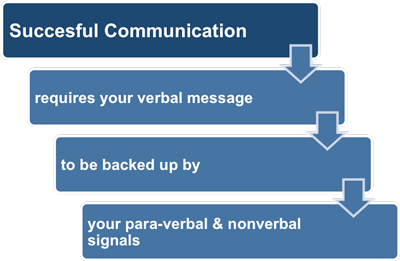 |
The more you are able to master your own emotions during communications the more effective you will be and the more aware you will be of your own nonverbal signals and how they could be interpreted. The more you actively observe those you communicate with the greater your skill will become in ensuring that your words have a 'perfect' correlation with your para-verbal and nonverbal signals.
Whilst it is important to be aware of the nonverbal signs people exhibit during this process, using and developing your emotional intelligence is far more beneficial than worrying unnecessarily about decoding all of the subtleties of people's body language.
You may also be interested in:
Effective Communication in the Workplace | Workplace Communication Styles | Recognizing Workplace Communication Styles | Perceptual Preferences | Attitudes to Communications | Using the RESULT Principle | Barriers to Communication.



